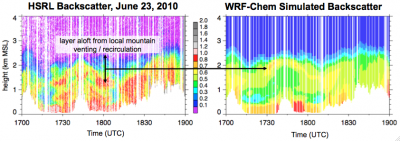New Product Organizes Data for Use by Modelers
Published: 1 September 2012
Knowledge of a wide range of meteorological, chemical, and aerosol quantities and properties is needed to fully understand the key processes that affect aerosol life cycle. Field campaign and operational measurements of aerosol properties and trace gas chemistry are often available in a wide range of formats. As a result, scientists usually spend a large amount of time converting the data before they can address their science topics. A newly developed data product called the Aerosol Modeling Testbed (AMT) collects and organizes a wide range of ARM and operational data into a single data set for modelers or any scientist wishing to analyze field campaign data.

The testbed case for the CARES data collected during June 2010 is currently in evaluation mode, and comments on the product are welcome and should be shared with Jerome Fast, Jerome.Fast@pnnl.gov. The product will be updated when the evaluation is completed, and additional testbed cases from other ARM field campaigns will be added in the future.
More information on AMT is available at the product web page. To access these data, log in to the Data Archive. (Go here to request an account.)
The ARM Climate Research Facility is a DOE Office of Science user facility. The ARM Facility is operated by nine DOE national laboratories, including .
Keep up with the Atmospheric Observer
Updates on ARM news, events, and opportunities delivered to your inbox
ARM User Profile
ARM welcomes users from all institutions and nations. A free ARM user account is needed to access ARM data.


















